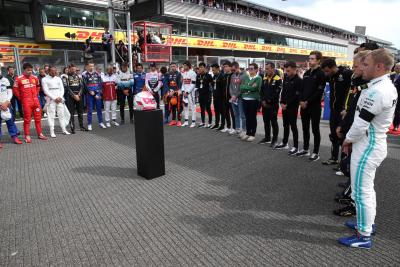FIA clears drivers of wrongdoing in report on Hubert’s fatal crash
The FIA has published its investigation report into the accident which killed Anthoine Hubert and seriously injured Juan Manuel Correa during a Formula 2 race at Spa-Francorchamps last year.
Hubert lost his life in a crash on Lap 2 of the F2 Feature Race at the Belgian circuit, with Correa also suffering serious right leg injuries and respiratory failure that resulted in him being placed in an induced coma for two weeks. The incident shocked the entire motorsport world with tributes made from across the globe.
The FIA has published its investigation report into the accident which killed Anthoine Hubert and seriously injured Juan Manuel Correa during a Formula 2 race at Spa-Francorchamps last year.
Hubert lost his life in a crash on Lap 2 of the F2 Feature Race at the Belgian circuit, with Correa also suffering serious right leg injuries and respiratory failure that resulted in him being placed in an induced coma for two weeks. The incident shocked the entire motorsport world with tributes made from across the globe.
The sport’s governing body launched an investigation into the incident reviewed by the FIA Research Working Group and approved by the FIA Safety Commission led by Sir Patrick Head. The investigation looked into the videos available from the incident, team data loggers and accident data loggers to breakdown the details of the crash and the outcome.
The FIA have cleared any of the four drivers involved – Hubert, Correa, Ralph Baschung and Giuliano Alesi – of any wrongdoing in the incident as well as the race and medical crews which oversaw the response to the incident.
In a conclusion report into the FIA investigation, the findings showed:
• A chain of events resulted in a protracted and complex crash sequence involving four drivers, which ultimately led to a high-speed ‘T-Bone’ type impact between the cars of Juan Manuel Correa and Anthoine Hubert.
• The dynamics of the car-to-car impact in terms of speed and trajectory were such that an extremely high level of energy was transferred and dissipated, translating into non-survivable trauma to Anthoine Hubert and very serious injuries to Juan Manuel Correa.
• There was no single specific cause but multiple contributory factors giving rise to the severity of the accident were identified, following a detailed analysis of the various phases of the accident.
• The investigation found no evidence that any driver failed to react appropriately in response to the yellow flag signal or to the circumstances on track.
• The reaction of marshals and race control in deploying signalling and rescue services in relation to the accident is considered timely and good.
The report explained Hubert lost control of his car after colliding with Boschung as the pair tried to avoid Alesi who had crashed ahead of them. Hubert initially hit the barriers at 216km/h with a 33.7g impact before being thrown into the path of Correa. The car-on-car impact was logged at 218km/h with a peak force of 81.8g on Hubert’s stationary car and 65.1g on Correa’s car.
The race was immediately red-flagged the first extraction team arrived at the scene of the crash two minutes after the accident occurred and despite the best efforts from the medical team Hubert succumbed to his injuries at the circuit.
The FIA has also confirmed safety improvements learnt from the accident will be integrated into its ongoing safety work. In 2019 the FIA safety department conducted investigations into 28 serious and fatal accidents related to circuit racing.
Correa has undergone two lengthy surgeries to save his right leg and is continuing to recover from the incident. He remains determined to returning to racing again in the future and in tribute to Hubert.
“My passion is still racing,” Correa said last November. “A friend asked me if this ends my F1 dream. I told him that an accident does not end the dream, but it does make you think if you want to take a risk for a dream.”


![Johann Zarco, LCR, Honda RC213V, 2024 San Marino MotoGP, Misano, action [Gold & Goose]](https://cdn.crash.net/styles/thumbnail/s3/2024-09/GnG_1166323_HiRes.jpg?itok=vpgrU7Q4)

![Jack Miller, KTM Factory Racing, KTM RC16, San Marino MotoGP, Misano, action [Gold & Goose]](https://cdn.crash.net/styles/thumbnail/s3/2024-09/GnG_1167624_HiRes.jpg?itok=iz7mA4EQ)


![Fabio Quartararo, Monster Energy Yamaha Racing, Yamaha M1, 2024 MotoGP, Misano Test, action [Gold & Goose]](https://cdn.crash.net/styles/thumbnail/s3/2024-09/GnG_1168928_HiRes.jpg?itok=fcYSole_)
![Toprak Razgatlioglu, ROKiT BMW Motorrad, BMW M 1000 RR, Magny-Cours, WorldSBK [Gold & Goose]](https://cdn.crash.net/styles/thumbnail/s3/2024-09/GnG_1165133_HiRes.jpg?itok=GD5SVNVG)

